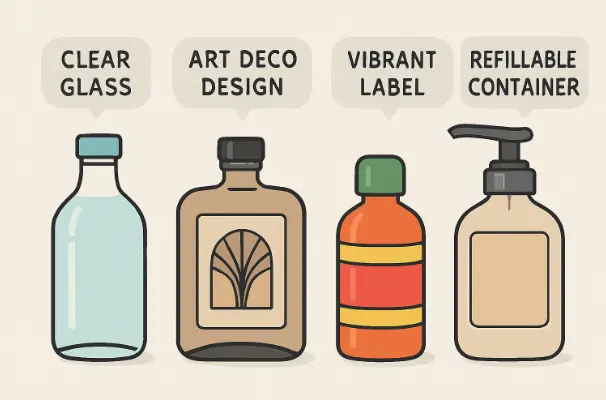As brands strive to captivate consumers in an increasingly crowded marketplace, 2025 is shaping up to be a defining year for packaging innovation. Nowhere is this more evident than in the rapidly evolving world of bottles and jars, where design is blending sustainability, technology, and artistry to reshape consumer expectations. Whether it’s a bold new material or a creative design detail, packaging does more than contain—it tells a brand’s story and forges a tactile connection with buyers. Modern consumers are influenced not only by eco-friendliness and functionality, but also by how product presentation resonates with their personal values and preferences. Incorporating custom labels on bottles and jars further elevates the experience, allowing for personalization that can instantly catch the eye on store shelves.
This surge in creative direction in branding emphasizes transparency, authenticity, and sustainable practices. Trends such as refillable containers and augmented reality are used to foster loyalty and increase market share, with presentation impacting two-thirds of purchase decisions globally. Marketers harness styles such as Art Deco, minimalist design, and tech customization to enhance their brand narratives. The equilibrium between aesthetics and functionality is critical for attracting millennial and Gen Z consumers who favor meaningful and interactive experiences. Adapting to these trends can enhance brand differentiation and customer engagement, with a focus on innovative packaging poised to strengthen authentic connections by 2025.
Sustainable Packaging Solutions
Eco-conscious consumers are increasingly making their purchasing decisions based on the sustainability of packaging, prompting brands to reassess their materials and production processes. Glass bottles and jars have gained popularity due to their 100% recyclability and ability to be repurposed—a stark contrast to the lifecycle of single-use plastics. This not only helps brands align with climate goals but also serves as a powerful marketing tool in markets like North America and Europe, where green initiatives are vital. Companies such as L’Oréal and Coca-Cola are exploring refillable glass solutions and collaborations for carbon-neutral packaging, a shift expected to accelerate as policies tighten and consumer advocacy grows.
Art Deco Revival
Nostalgia is having a major moment in 2025, nowhere more so than in the comeback of Art Deco-inspired packaging. Featuring symmetrical lines, luxe metallics, deep color contrasts, and geometric flourishes, this design style appeals to consumers’ love for vintage sophistication while delivering a sense of exclusivity. Brands seeking to launch limited-edition products or premium collections are reviving these motifs to differentiate themselves from the monotony of utilitarian packaging. This trend is seen across luxury spirits, beauty serums, and even food jars, driven by a broader resurgence of retro styles in mainstream culture
Customization and Personalization
Modern consumers desire products that feel bespoke. In response, brands are pushing the limits with customizable bottle shapes, unique finishes, and limited-edition collectible labels. For instance, beverage companies are rolling out QR code-enabled labels that unlock a personalized AR experience based on the buyer’s preferences, while cosmetics firms are allowing customers to emboss their names onto product jars. These personalized touches deepen customer engagement, foster brand loyalty, and give products a viral edge on social platforms. The strategic use of custom labels further enables this movement, ensuring every product tells its own story.
Integration of Smart Packaging
The digital transformation of packaging is making physical products portals for interactive content. Smart packaging solutions include embedded NFC chips, QR codes, and even augmented reality overlays, offering a seamless blend of online and offline engagement. For example, a consumer might scan a jar’s label to access recipe ideas, trace ingredient sourcing, or receive care tips tailored to them. This not only enriches the product experience but also enables brands to gather valuable consumer data for more precise marketing efforts. These innovations are fast becoming the mark of leading-edge brands eager to delight and inform tech-savvy shoppers.
Minimalist and Transparent Designs
In 2025, less is more, with brands gravitating toward minimalist layouts that emphasize understated elegance and trustworthiness. Packaging features simple fonts, subtle textures, and abundant white space—drawing the consumer’s eye to the product’s innate value. Transparent bottles and jars are particularly sought after in the skincare and specialty food sectors, as they convey authenticity and enable consumers to assess product quality for themselves. This trend reflects a broader shift in consumer preferences toward brands that prioritize transparency and sustainability.
Bold Colors and Unique Finishes
To catch the customer’s attention amidst a plethora of choices, many brands are opting for vibrant color palettes and specialty finishes such as matte, holographic, or frosted glass. Unique visual cues help products convey their brand personality and communicate the intended experience—such as freshness for beverages or luxury for perfumes. Strategic color choices, influenced by global color trend forecasts, create an instant shelf impact and enable brands to communicate their value propositions at a glance. This approach is being used not just in premium sectors but increasingly by challenger brands aiming for rapid recognition.
Refillable and Reusable Packaging
The demand for refillable and reusable packaging solutions is rising rapidly, especially amongst eco-conscious beauty and personal care brands. This approach offers a two-pronged benefit: reducing packaging waste while giving consumers an economically savvy option through refills. Brands are developing stylish, robust containers built for longevity, along with convenient in-store and online refill systems. This model is moving from niche to mainstream, with both startup and legacy brands making significant new launches based on this principle.
Conclusion
The evolution of bottle and jar packaging in 2025 reflects a dynamic blending of sustainability, design innovation, and smart technology. Today’s consumers expect more than basic function; they seek packaging that embodies their values, engages their senses, and connects them seamlessly to brand stories. For businesses, adopting these trends represents not just an opportunity to differentiate but also a strategic imperative for building long-term loyalty and growth in a competitive global market.
Also Read- The Rise of eSIM Technology: Transforming Mobile Connectivity

